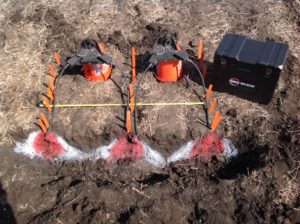There are many variables that play a role in nitrogen management. Placement is sometimes overlooked – mainly because for years there hasn’t been many choices in application methods – with a limited window of application.
Where N is applied within the row is important
Traditional sidedress methods apply N in the middle of the crop row – nearly 15 inches from the stalk base. Yet, a corn plant acquires more than 60% of its N from a horizontal radius of approximately 7 inches.1 With 360 Y-DROP, farmers can apply N within 2 to 3 inches of the stalk base – that means a large percentage of the plant’s most viable roots are within the 360 Y-DROP application zone.
The anatomy of the root zone
Corn roots grow both vertically and horizontally with differing density throughout the root zone. In most cases, corn roots intertwine with the roots from the adjacent row 10 in. to 12 in. below the soil surface but with less root density than in the area directly below the stalk.
360 Y-DROP nitrogen application is focused on the area of the root zone that is with within a radius below the stalk base (the area shaded in red in the photo). This part of the root system has the highest density of roots – root hairs and root to soil contact. This is also the area of the root system we most often dig up to evaluate root health as it is the heart of the root system. The roots in this part of the root zone are typically the most viable to maintain plant uptake of both water and plant nutrients.

Maximize nutrient uptake and microbial stimulation
Late-season N application plays two roles: it provides needed nitrate and ammonium for plant nutrition and it stimulates microbes in the soil to mineralize and release late-season ammonium.
A common question regarding the placement of N with 360 Y-DROP is if it’s necessary to apply N on every row, where N is placed on both sides of the stalk base. Or, if every other row placement, where N is placed along the stalk base on only one side is good enough.
In order to maximize late season N uptake and available nitrogen available for the plant, placing N on both sides of the stalk base is recommended. The best placement for consistent uptake and the right rate are key. It is very important to deliver the nutrients you apply by the 360 Y-DROP to a location that will most consistently move nutrients and stimulate microbial activity throughout the root zone area shaded in red – located in a radius beneath the stalk base.
With the natural funneling structure of a corn plant, a 0.10 in. of rain across a field is magnified at the base of the corn plant. Funneled water from the corn plant helps move nutrients into the soil and root zone on both sides of the plant both evenly and more efficiently even in dry conditions. In contrast, if we apply nutrients to only one side of the stalk base, the likelihood that nutrients move throughout the entire area shaded in red is less likely and you could be missing an opportunity to reach full potential and maximize nutrient efficiency and uptake.
Check out Ron Lloyd’s blog to learn more about 360 Y-DROP and visit our nitrogen management page – www.360yieldcenter.com/nitrogen
– to see how you can manage nitrogen differently.
1 Hodgen, P.J., Ferguson, R.B., Shanahan, J.F., & Schepers, J.S. (2009). Uptake of point source depleted N fertilizer by neighboring corn plants. Agronomy Journal, 101, 99-105.